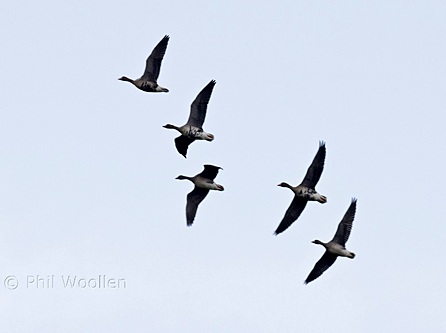Site menu:
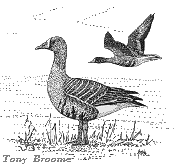
February 2012 Newsletter
Geese on the Dee Estuary Part 2.
Submission of 2011 Records.
January Bird News.
Forthcoming Events.
Latest Newsletter.
Geese on the Dee Estuary
Part 2.
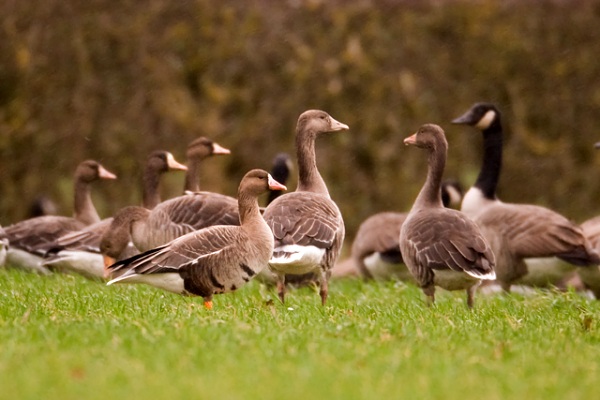
It was good to see hundreds of
Pink-footed Geese around Burton and Parkgate in January after having
published my article last month. But
the main interest was with the build up of White-fronted
Geese and the arrival of up to three Bean Geese, so this month I write
about these two species putting this winter's records in
context.
The White-fronted Goose
There are two races of 'White-fronts' which occur in this country, known as 'European' and 'Greenland' White-fronted Geese. Neither race is by any means common around the Dee but whereas the European race does occur here at least one in every three years the Greenland race is very much a vagrant.
The graph below shows the max number of European White-fronted Geese recorded on the ground each year from when the Cheshire (and Wirral) Bird Reports started in 1964 to the present day. This current winter is the best one for this species over that time period with a flock in double figures reported most days from mid-November through to January with at least 50 present for most of January, max 59 on the 24th. They have been centred around the new RSPB Burton Mere Wetlands Reserve with birds either on the reserve itself or in the fields to the south and east.
There was a larger flock counted in early 1979 with 64 present, but they were here on only one day, a smaller flock of just seven to 12 stayed for a month.
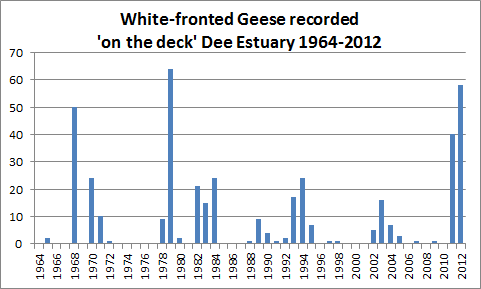
Over the years good size flocks of White-fronted Geese have been recorded over-flying our area, in most cases it was not possible to determine which race they were. There seems to be no correlation with these over-flying birds and birds on the ground. For example 58 flew over Hilbre on Jan 8th 2010 and another 212 were over Hilbre on Jan 25th 1996, but in both these years we didn't see any at all elsewhere on the estuary. 220 flying SW at Red Rocks on December 21st 1982 is the highest count of these geese since at least 1964.
Going back pre-1964 historical records indicate that they were never very numerous on the Dee Estuary, but the same cannot be said of the Mersey. There seems to have been a sharp increase of birds during the early 1900's reaching 500 by 1920 then increasing to a max of over 4,000 by 1947. They roosted on the marshes on the southern side of the estuary and fed in the flood meadows along the River Dee by Aldersley (up river of Chester). During the 1950s there was a sharp decrease from 1,100 in 1953 to just 100 in 1959 with the disturbance caused by the construction of Stanlow Oil Refinery a likely cause. The 1964 Cheshire Bird Report records just 56 on the Mersey marshes and they have been largely absent ever since.
The Bean Goose
To quote Cabot "a taxonomic nightmare with disagreement among experts on the numbers of its subspecies/species.......pink-footed goose...classified by some ornithologists as a subspecies of the bean goose"! Nevertheless, the situation in the UK is reasonably straightforward with two sub-species present - the Taiga Bean Goose and Tundra Bean Goose, 'taiga' and 'tundra' indicating the habitat in which they breed, which is across northern Europe and Asia. Both are rare in the UK with the Taiga a regular winter visitor in small numbers at just two traditional sites, whereas the Tundra is far more irregular although there are the occasional influxes, usually associated with an influx of White-fronted Geese, as has happened this winter.
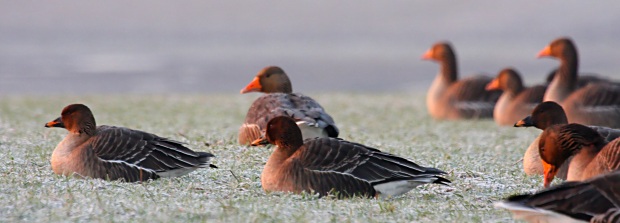
© Paul Brady, RSPB Dee Estuary.
We were hopeful of seeing one or two here on the Dee Estuary but without any great expectation as they are so rare here. But two duly turned up on Jan 2nd and were then seen on several dates through the month, increasing to three on the 14th. They were usually with either Greylags or Pinkfeet, mostly in the fields to the south-east of Burton Mere Wetlands and either side of Puddington Lane. Many sightings were made mid to late afternoon.
In recent times small flocks have turned up around the Mersey Estuary with nine in 2005 and eight in 1984, but you have to go all the way back to 1961 for the last Dee Estuary record with nine in fields by Shotton on November 22nd. One, probably injured, bird was on Burton Marsh in May 1959 with 15 in a field near Puddington in January 1908 the only further record of a flock. Apart from that there are records of eight single birds shot on separate occasions, usually around Burton, going back as far as 1872.
A rare bird indeed but the same cannot be said of Europe as a whole with about 600,000 Tundra Bean Geese over-wintering; the numbers of this sub-species seem to be fairly stable. The same cannot be said of Taiga Bean Geese as the global population has plummeted from 100,000 to just 65,000 in the last 15 years, most spend the winter in southern Sweden, Poland, Germany and Denmark.
References/Sources of Information:
1. Cheshire and Wirral Bird Reports
1964 to 2010.
2. Clwyd/North-east Wales Bird Reports - various to 2010.
3. Latest Sightings archive - www.deeestuary.co.uk (many thanks to
everyone
who sent their sightings to me).
4. Wetland Bird Survey Reports, 1995-96 to 2009-10.
5. Goose Bulletin, Issue 13 - November 2011.
6. Waterlife, WWT, Jan-Mar 2012.
7. British Birds 105, January 2012, Recent Reports.
8. T.A. Coward, The Fauna of Cheshire, Witherby, 1910.
9. G.B. Farrar, Feathered Folk of an Estuary, Country Life, 1938.
10. T. Hedley Bell, The Birds of Cheshire, Sheratt, 1962.
11. Eric Hardy, The Birds of the Liverpool Area, T.Buncle & CO,
Ltd, 1941.
12. G.L. Atkinson-Willes, Wildfowl in Great Britain, HMSO,1963.
13. David Cabot, Wildfowl, New Naturalist No.110, Collins, 2009.
Top of Page
Submission of 2011 Records
Firstly, all the records which are NOT County rarities which are sent to myself (Richard Smith) for inclusion into this website are sent on and included in the Cheshire & Wirral and North-East Wales data bases, and these are then sent to the compilers when writing the Bird Reports. Obviously, as I cannot fill in a rarity form for birds I haven't seen, I don't send in rarity details - you will have to do that yourselves! It is VERY IMPORTANT to fill a rarity form in and get your record accepted by the relevant rarity panel - otherwise your record will not be official and it will be lost to posterity.
Please feel free to submit your records
directly, that way you will get your name mentioned in the Report
rather than being
lumped in with the 'Dee Estuary Website', but more importantly it would
be greatly appreciated if you could submit any additional records,
including rarities, as follows:
For submitting Cheshire and Wirral records,
including rarities, see details in the CAWOS website - www.cawos.org - click
on 'recording' then 'submission of records'.
For submitting for the North-East Wales area
(Flintshire and Denbighshire) see the Clwyd Bird Recording Group
website - www.cbrg.org.uk
- and click on 'will you help by submitting records'.
I should like to add that where you
have managed to take a photograph of a bird which is a County Rarity,
of whatever quality, please include it with the description. If the
photo is of reasonable quality then that alone will often be enough to
get it accepted. But please include any features of the bird which the
photograph may have missed, together with details of behaviour, precise
location etc.
Top of Page
January Bird News
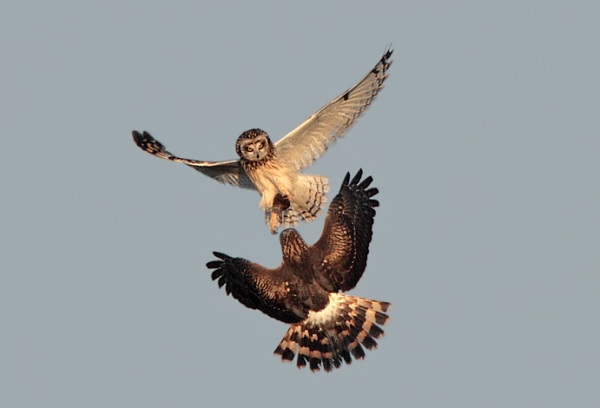
January 16th © Steve Round.
A single Great White Egret has now been on the estuary since September 24th, it was joined this month by two others which were first seen on Jan 4th at Inner Marsh Farm then several times at Parkgate where they accompanied our 'resident' bird. The last report was on the 13th and it was probably these two birds which were subsequently seen flying over Frodsham Marsh on the 15th.
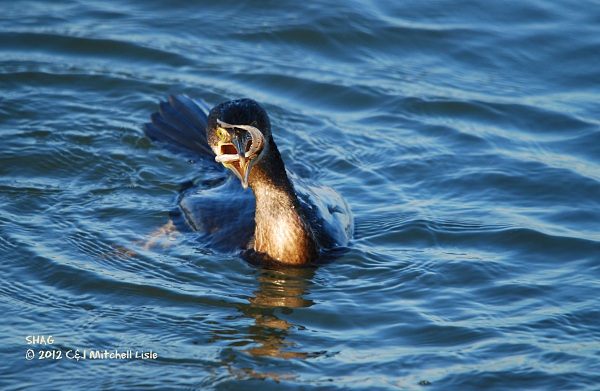
A Spoonbill was on Warren Farm Fields by Point of Ayr early in the moth, it then spent several days on Oakenholt Marsh before finding its way to Burton Mere Wetlands and then Parkgate Marsh. Also at Oakenholt Marsh was an excellent count of at least 80 Twite. There were three counts of eight Short-eared Owls on Burton Marsh whereas the maximum count of Hen Harriers was four with three ring-tails and a sub-adult grey male, although the latter was only seen once.
Purple Sandpipers reached 23 on the pontoon at New Brighton Marine Lake, with similar numbers on Hilbre.
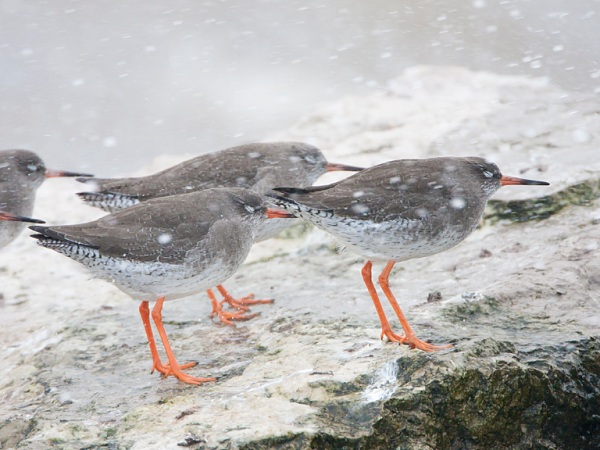
© Matt Thomas, see 'From the Muddy Banks of the Dee' Blog.
Richard Smith.
What to expect in February
At Hilbre Purple Sandpipers usually peak this month with the pontoon on New Brighton Marine Lake also a good place to see them, we can expect to see more than 20 at both locations. Some years Little Gulls start to move northwards through Liverpool Bay this month. Another species which may be starting to move north is the Avocet, look out for them at the Connah's Quay Reserve and Burton Mere Wetlands.
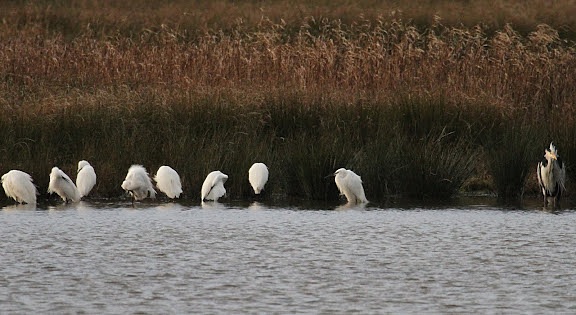
Forthcoming Events
February Highest Spring Tides (Liverpool)
Also
see Tides
page.
10th February, 12.38hrs (GMT), 9.8m.
11th February, 13.18hrs (GMT), 9.8m.
Forthcoming Events
Organised by the Wirral
Ranger Service , Flintshire Countryside Service and/or the
RSPB:
All these events and walks have bird interest, even those not
advertised specifically for birdwatching. No need to book for these
events unless specified - please check below.
Also see 2012 Events Diary.
Thursday 9th February, 10am start, approx
2hours. RSPB Flint Point and
Oakenholt Marsh Walk.
The marshes off Flint and Oakenholt are perhaps the most important part
of the famous Dee estuary so why not come along for a gentle stroll to
find out why. Friendly staff and volunteers will be on hand
to point
out the birds with telescopes.
We hope to see thousands of
wading birds being driven in by a rising tide including spectacular
numbers of black-tailed godwits, oystercatchers and dunlin.
Other
specialities of the area include twite, peregrine and pintail.
The area is quite exposed so please bring weatherproof clothing and
good walking footwear.
Meet at Flint Lifeboat Station car park next to Flint Castle.
This is a free event but booking
is essential - please ring 0151 353 8478 or 0151
336 7681.
Saturday 11th February, High tide
Birdwatch at King’s Gap, Hoylake
Shore, starting
at 11:00 am.
You
will discover why Wirral’s foreshore is an internationally protected
site when you join the Dee Estuary Voluntary Wardens, Coastal Rangers
and the RSPB on this winter birdwatch at Hoylake. Organised as part of
Wirral’s Year of Coast and Countryside. High tide at 1pm, height
9.8m.
No need to book. Ring 0151 648 4371 for further info.
Sunday 19th February, 3.30pm start, RSPB
Raptor Watch at Parkgate.
Pop along at any point until sunset for great views of the rare hen
harrier. Merlin, Peregrine and Short-eared owls are also a
regular
sightings here. Meet at Old Baths car park overlooking the marsh. Ring
0151 353 8478 or 0151 336 7681 for more info.
Sunday 26th February, 10.30am start, 2 hours approx, RSPB Guided Walk
at the Point of Ayr.
Point of Ayr is a fantastic mosaic of habitats on the outer edge of the
famous Dee Estuary and is a vital wintering spot for thousands of
birds. Join the experts from the RSPB for a free guided walk
showcasing the wildlife of the area.
Meet in the Smugglers Inn Car Park, Station Road, Talacre.
This is a free event but booking
is essential - please ring 0151 353 8478 or 0151
336 7681.
Friday 9th March, 10am start, RSPB High Tide Birdwatch at Parkgate.
High tide at 11.36am, 9.9m. The
marshes of Parkgate and the surrounding areas hold masses of small
mammals and bird life. Will this year’s tides flood the
entire
marsh and cause the wildlife spectacle hundreds of people travel miles
to see?
RSPB
Staff and volunteers will be on hand to help identify the birds and
explain what is happening and why. Meet at Old Baths car park
overlooking the marsh. Ring 0151 353 8478 or 0151 336 7681 for more
info.
Saturday 10th March, start 9.30am, High tide birdwatch at King’s Gap, Hoylake.
You
will discover why Wirral’s foreshore is an internationally protected
site when you join the Dee Estuary Voluntary Wardens, Coastal Rangers
and the RSPB on this winter birdwatch at Hoylake. Organised as part of
Wirral’s Year of Coast and Countryside. High tide at 11.57am,
10.0m
No need to book. Ring
0151 648 4371 for
more info.
Saturday 10th March, 10am start, RSPB High Tide Birdwatch at Parkgate.
High tide at 12.16pm, 10.0m. See 9th March event for info.
Sunday 11th March, 10am start, RSPB High Tide Birdwatch at Parkgate.
High tide at 12.57pm, 9.9m. See 9th March event for info.
|
